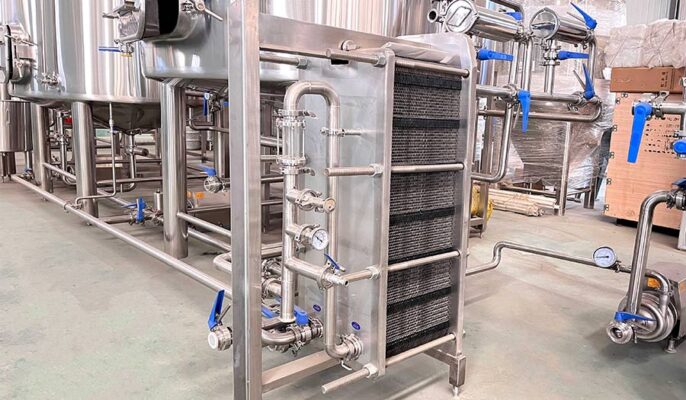The automated brewing equipment market is experiencing significant growth and is expected to continue its upward trend in the coming years. The automatic beer brewing equipment market is expected to experience much growth from 2024 to 2031, driven by several key factors. A combination of technological advancements, growing demand for automatic beer brewing equipment, and favorable government policies is expected to drive this growth.
What is automated brewing equipment?
Brewing has always been a manual and often labor-intensive task, but with the advent of modern technology, many aspects of brewing can be automated, ensuring consistency, efficiency, and optimal results.
Components of an automatic brewing system:
- Controller: The brains of the system, which can be programmed to perform specific brewing tasks.
- Heating element: Ensures water or beer reaches the right temperature.
- Pump: transfers liquid from one container to another.
- Sensors: Check various parameters such as temperature, pressure, and pH.
- Containers: kettles, saccharification barrels, fermentation tanks, and other containers.
Advantages of automated brewing equipment
- Connectivity: Modern brewing systems can often connect to Wi-Fi, allowing users to check and control their brew from a smartphone or computer.
- Friendly design: Manufacturers pay more attention to sustainability, thereby achieving energy-saving design.
- Integration with artificial intelligence: Some advanced systems use artificial intelligence to refine the brewing process, learning from previous batches to improve results.
Automatic brewing systems are revolutionizing the way drinks are brewed, blending traditional methods with modern technology. Suitable for both novice brewers and seasoned professionals, these systems guarantee a worry-free brewing experience.
Automated brewing equipment market analysis
Brewery equipment includes apparatus and equipment for the production of alcoholic and fermented beverages, including beer, from grains. They are used in large and small breweries to produce and process beer of all sizes. Beer is a low-calorie alternative to other beverages and, besides to being rich in vitamin B, vitamin B3, and vitamin B6, it also provides our body with important fiber content. The global automatic brewing equipment market is worth US$6.86 billion in 2021 and is expected to reach US$11,016.59 million by 2029, with a compound annual growth rate of 6.10% during the forecast period of 2022-2029.
Automatic brewing equipment market dynamics analysis
The number of small breweries is increasing
In 2021, microbreweries and brewpubs accounted for more than 56% of the 9,247 breweries in the United States. Across Europe, there has been an increase in the number of microbreweries and brewpubs, especially small craft breweries producing less than 30,000 barrels per year. Additionally, brewpub sales are growing, and small breweries account for about two-thirds of the growth in the craft beer category. Thus, the beer equipment market is expected to grow faster than the beer industry throughout the forecast period.
Increased beer consumption brings opportunities
Beer is one of the most popular and consumed alcoholic beverages worldwide. Increasing population growth in developing countries has driven the growth of the beer industry. In turn, the demand for brewery equipment is expected to increase throughout the forecast period.
Beer and beverage industry growth
The growth and expansion of food and beverages, especially in developing economies, will provide many opportunities for the growth of the market. Keeping up with advancements in manufacturing/production technology may also be beneficial to the market as a whole.
Constraints
One of the major hurdles in the beer equipment market is the rising cost of electricity and energy required to operate processing machinery. The beer industry is expanding and has bright prospects. The brewing industry requires large amounts of energy to run its facilities , as well as for refrigeration, lighting, and other mechanical processes. This will hinder the market growth rate.

Automated brewing equipment market scope
The automatic brewing equipment market is segmented based on brewery type, equipment type, and material type. The growth of these segments will help you analyze the growing segments in the industry and provide users with valuable market overviews and market insights to help them make strategic decisions to identify core market applications.
Brewery type
- Large breweries
- Craft breweries
- Small breweries
- Beer bar
- Restaurant
Equipment type
- Large brewery equipment
- Milling equipment
- Brewery
- Mashing kettle
- Watertown
- Wort kettle
- Vortexer
- Cooling equipment
- Fermentation equipment
- Filtering and filling equipment
- Cleaning system
- Bright beer cans
- Compressor
- Craft beer equipment
Automated material types
- Brass
- Copper
- Aluminum
- Stainless steel
- Mild steel
Automated brewing equipment worth learning
Today, there are automated multi-vessel systems to meet the needs of breweries, as well as specialized wort aeration and oxygenation equipment to meet the needs of breweries. Improve the brewing process. Pneumatic conveyors have been developed to remove spent grain; tank systems save water and energy by using compressed air instead of carbon dioxide and have recyclable inner bags. At the same time, sustainable design and construction practices are receiving increasing attention environmental stewardship, future economic vitality, and client social enrichment.
Leverage automation to reduce waste
The beer industry is undergoing a major transformation due to advances in automation technology. Automated brewing systems offer brewers exciting opportunities to increase production levels while reducing resource usage and costs. These systems enable brands to check temperature, pressure, and other variables with precision during the production phase, resulting in higher-quality products and increased end-user satisfaction. Additionally, data collected through sensor-connected devices can optimize processes, create predictive analytics models to predict future demand and better plan inventory levels.




